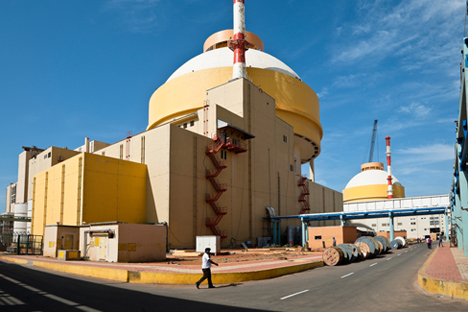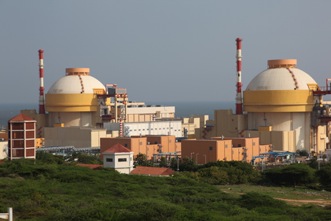Coming to India’s aid on KNPP’s spent nuclear fuel

KNPP had adequate provisions for safe storage of spent fuel. Source: Press Photo
One of the core points of litigants who slapped cases in the Indian Supreme Court against the Kudankulam Nuclear Power Plant (KNPP) in southern Indian state of Tamil Nadu, being built with the Russian technical assistance, pertained to the nuclear waste or spent nuclear fuel (SNF).
The petitioners had told the court that under the agreement of 1988 with the then Soviet Union, nuclear waste had to be shifted back to Russia and the clearances for site and environment were based on this factor. However, a new agreement was signed between in 1998 under which nuclear waste had to be retained and stored in India. This was done at the request of India and Russia, like a well meaning friend of India, had acquiesced to the Indian request. This is an important fact that must be kept in consideration while adjudging the Russian intentions behind the KNPP project.
Why India Made This Request
An Indian official, familiar with the broad contours of the Indo-Russian cooperation in the vital field of civilian nuclear energy cooperation, told this writer that India made this request to Russia in its own larger strategic interests.
The Nuclear Power Corporation India Limited (NPCIL), which owns and runs nuclear power plants in India, including the KNPP, the Ministry of Environment and Forests and the Department of Atomic Energy (DAE) gave their own detailed submissions to the Indian Supreme Court with regard to this issue. In their counter affidavit on the various issues posed by the appellants, the NPCIL and the DAE told the court that even though, as per the earlier agreement of 1988 between India and USSR, spent fuel had to be transported to Russia, in a subsequent agreement in 1998 signed between two countries, the Indian government had insisted that it should be allowed to retain the spent fuel in India so that it could be recycled and used.
In many ways spent nuclear fuel or SNF is a strategic asset for a nation. These Indian agencies told the court that the SNF discharged from the reactor contains materials suitable for recycling and hence could be reused to produce electricity.
They argued that the spent fuel contains minerals, both uranium and plutonium, which constitutes about 96 percent and 1 percent of the spent fuel respectively. They maintained that 97 percent of the SNF is capable of being re-used. The remaining 3 percent contains other components that are normally not recyclable.
They also pointed out that KNPP had adequate provisions for safe storage of spent fuel. In KNPP, they argued, the spent fuel pool (SFP) is located inside the primary containment, adjacent to reactor cavity which has the capacity to store fuel equivalent to 7 years of full power operation of the plant.
Indian Capability for Reprocessing SNF
Related:
Russian expert vouches for Kudankulam safety
The official told this writer that India has got the capability for re-processing SNF. Currently, India has three operating processing plants based on solvent extraction process – one each at Trombay, Tarapur and Kalpakkam.
Trombay plant reprocesses the spent fuel from research reactors with the capacity of 60 tonnes per year. The plants at Tarapur and Kalpakkan process off-site fuels from Pressurized Heavy Water Reactors (PHWRs) with operating capacity of 100 tonnes per year each, the official explained.
Besides, additional re-processing facilities are being set up with the active participation of the Indian industry to accelerate the programme.
The Argument Gets SC Nod
This argument of the Indian agencies found support from the Indian Supreme Court which gave its nod to the Kudankulam project on May 6.
Sample the court’s observation in this context: “We notice that with the limited resources of uranium available in India, the indigenous achievable NP is estimated to be 10,000 MWe by PHWR, without re-processing. With the help of re-processing, the achievable capacity could go up to 63000 MWe imported LWR and recycling LWR fuel to 275,000 MWe, by 2052.”
Thus, the central argument of the NPCIL in not sending SNF back to Russia and retaining it in India was that re-processing of spent fuel is the key to the country’s three- stage nuclear power programme.
Incidentally, the Russian reactors installed at KNPP are of VVER type. More than 20 VVER-1000 are operating in Russia and in other countries. While finalizing the contract for KNPP, additional safety features were specified which have been incorporated and their functionality is being established during commissioning.
The writer is a New Delhi-based journalist-author and a strategic analyst.
All rights reserved by Rossiyskaya Gazeta.
Subscribe
to our newsletter!
Get the week's best stories straight to your inbox
